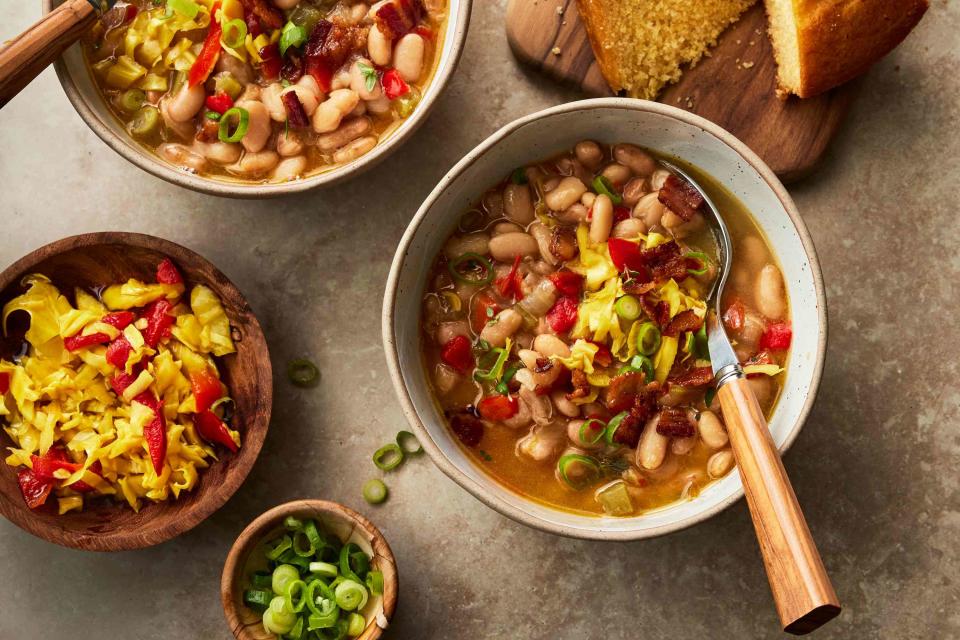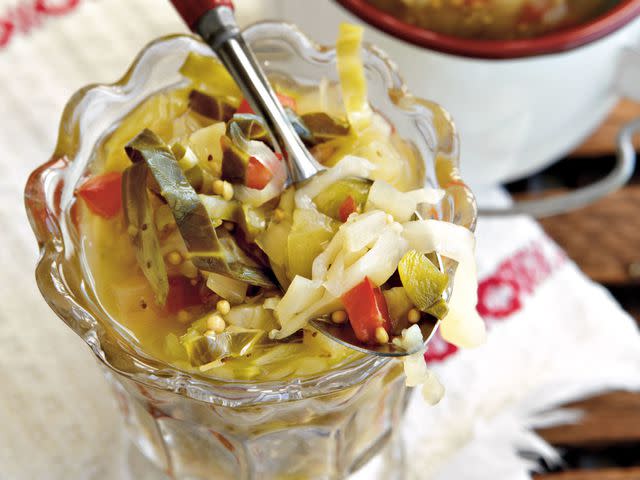An Appalachian Supper: Soup Beans, Chowchow, And Skillet Cornbread
The perfect mates for a Southern plate.

Greg DuPree; Food Stylist: Ali Ramee; Prop Stylist: Hannah Greenwood
Almost anyone who grew up in the Appalachian mountains, or were fed by someone who did, will attest that soup beans are one of the most common and beloved dishes. Most of them will quickly add, however, that the two other integral parts of the meal are skillet cornbread and a jar of chowchow.
Yes, for many families, chowchow is a staple whenever dried beans or peas are served. The role of chowchow is meted out a heaping spoonful at a time, there to perk up a plate of food that needs some acid, twang, and color—especially soup beans and cornbread, a humble meal that, although delicious, is otherwise drab. Two of the defining flavors of Appalachian cuisine are vinegar and pepper (from pungent black pepper to fiery chiles), often delivered in tangy, judiciously spiced, and slightly sweetened pickled vegetable relishes, including chowchow.
Homemade chowchow is a smart way to use up the ragtag assortment of vegetables from the end-of-season garden, when there’s not enough of any one thing to put up, but too much to let go to waste, what some people call the garden orphans. It’s as much a common concept as universal ingredient list or recipe. Most variations include cabbage, sweet and hot peppers, onions, and green tomatoes, although the proportions vary from cook to cook. It can also vary from year to year depending on what’s left in the garden just ahead of the first hard freeze that marks the season’s end. A pantry or basement shelf of homemade and home-canned jars of chowchow is a scrapbook of that year’s gleaning.

Not everyone makes their own chowchow these days, so thank goodness we can find great chowchow made in other kitchens by other hands at farmers' markets and at roadside stands. There are also a couple of worthwhile brands in most Southern grocery stores.
Most of us call it chowchow, but there are similar relishes in other parts of the South that go by the name piccalilli or mixed pickles. No one knows the definitive origin story of the term chowchow. The late Southern food historian John Egerton claimed that its origins can be linked to the flavorful sauces that Chinese railroad workers brought over in the 19th century, and that chowchow might be a derivation of the word chop.
Other historians posit that chowchow made its way South during the expulsion of the Acadian people from Nova Scotia to their settlement in Louisiana, and that chowchow comes from chou, the French word for cabbage.
It’s possible to eat soup beans, cornbread, and chowchow separately, but the combination of flavors, textures, and aromas are perfect mates.
For more Southern Living news, make sure to sign up for our newsletter!
Read the original article on Southern Living.

